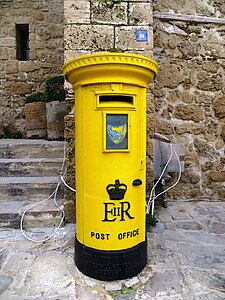Pillar box
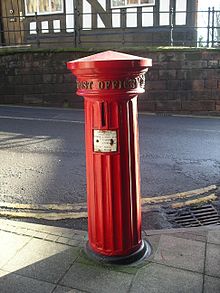
A pillar box is a type of free-standing post box. They are found in the United Kingdom and its associated the Crown Dependencies and British Overseas Territories, and, less commonly, in many members of the Commonwealth of Nations such as Cyprus, India, Gibraltar, Hong Kong, Malta, New Zealand and Sri Lanka, as well as in the Republic of Ireland. Pillar boxes were provided in territories administered by the United Kingdom, such as Mandatory Palestine, and territories with agency postal services provided by the British Post Office such as Bahrain, Dubai, Kuwait and Morocco. The United Kingdom also exported pillar boxes to countries that ran their own postal services, such as Argentina, Portugal and Uruguay.
Mail may also be deposited in lamp boxes or wall boxes that serve the same purpose as pillar boxes but are attached to a post or set into a wall. According to the Letter Box Study Group, there are more than 150 recognised designs and varieties of pillar boxes and wall boxes, not all of which have known surviving examples. Like the red telephone box, the red post box is regarded as a British cultural icon.[1] As of 2002[update], Royal Mail estimates there are over 115,000 post boxes in the United Kingdom.[1]
Construction


Most traditional British pillar boxes produced after 1905 are made of
Cast iron pillar box construction comprises three distinct main parts:
The cap sits on top of the carcass and is usually bolted down from inside. Some designs after 1965 do not have a separate cap. Caps can also be fitted with a separate bracket, normally of cast iron, which supports a Post Office Direction sign (POD) indicating the nearest Post Office.
The door contains the aperture or posting slot. It is hinged, should display the royal cypher of the monarch who was reigning at the time of installation, and may also be fitted with a collection plate showing the times of collection from that location. It is fitted with a brass security lock on the inside. The contractor for these locks has been the Chubb Locks company for many years. They are five-lever locks and each one can exhibit more than 6,500 combinations. There is no skeleton key for these locks. Each post box has its own set of keys and postal workers have to carry large bunches with them when clearing the boxes.
The carcass or body of the box supports the door and cap, and may protrude substantially down below ground level. This provides security and stability to the pillar box. There is a wirework cage inside to prevent mail falling out when the door is opened, a hinged letter chute to allow mail to fall into the collecting bag or sack, and a serrated hand-guard to prevent unauthorised tampering with the mail through the aperture.
History
This section includes a improve this section by introducing more precise citations. (February 2019) ) |
Pre-history
Before the introduction of pillar boxes, in the UK, it was customary to take outgoing mail to the nearest letter-receiving house or post office. Such houses were usually coaching inns or turnpike houses where the Royal Mail coach would stop to pick up and set down mails and passengers. People took their letters, in person, to the receiver, or postmaster, purchased a stamp (after 1840) and handed over the letter.
Channel Islands problem

The advent of the British wayside letter box can be traced to
Trollope subsequently arrived in
They were an instant success, despite some obvious problems with rainwater ingress. One Vaudin box still stands in Union Street,
First mainland and Isle of Wight boxes


The very first boxes erected in
The Post Office archives record that the first box in mainland Britain was erected in Botchergate,
Design problems
The first design for London, by Grissel & Son of Hoxton Ironworks was rather stubby and rectangular, although surmounted by a decorative ball. Erected in 1855, they were replaced because people complained that they were ugly. One survived and was earmarked for preservation in the early part of the 20th century. It was stored in a contractor's yard in London which was subject to a direct hit from a German bomb during the Blitz, thus destroying forever some important boxes. A photograph of this Grissel box together with a Giant Fluted box and a Penfold in the contractor's yard appeared in The Letter Box by Jean Young Farrugia.[6]
Moving towards a standard design
Standardisation of sorts came in 1857 with the deliberations of the Committee for Science & Art of the House of Lords. The committee designed a very ornate box festooned with Grecian-style decoration but, in a major oversight, devoid of any posting aperture, which meant they were hewn out of the cast iron locally, destroying the aesthetic of the box. Fifty were made for London and the big cities and three survive. One is in Salford Museum, Greater Manchester and the other two are at the BPMA in London. A similar, much-simplified version has survived painted green by An Post at the Cork Kent railway station, Ireland. Also to be found only in Ireland is one of the early boxes, now at the An Post exhibit on the history of the Irish postal service in the General Post Office, O'Connell Street, Dublin. It is the sole surviving "Ashworth" box of 1855 for the Northern District, that included all of the island of Ireland.
Prior to 1859 there was no standard colour, although there is evidence that the lettering and royal cypher were sometimes picked out in gold. In 1859, a bronze green colour became standard until 1874. Initially, it was thought that the green colour would be unobtrusive. Too unobtrusive, as it turned out – people kept walking into them. Red became the standard colour in 1874, although ten more years elapsed before every box in the UK had been repainted.
First National Standard boxes

The first real standard design came in 1859 with the First National Standard box.[7] These were also cast in two sizes for the first time to allow for heavier usage in big metropolitan areas. A number have survived across the UK, including Aberdeen, Brighton, Stoke, Worthing, London, World's End Hambledon, Bristol, Congresbury, and Newport, Isle of Wight. Similar boxes have also survived in Mauritius.
In the busy city of Liverpool, even these boxes could not provide the capacity and security required, so a special design was commissioned from the foundry of Cochrane Grove & Co of
-
"Liverpool Special" at Albert Dock
-
Top of First National Standard in Montpelier Road, Brighton
Penfolds
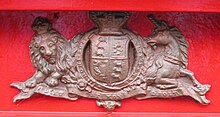
The most famous of the early designs is that named after the architect who designed it,
There are no original Penfolds in
The New Zealand boxes are the only Penfolds to bear the cypher of
-
Penfold Type PB8/1 at King's Parade, Cambridge.
-
Replica Penfold, erected at Tower Bridge in 1989.
-
Original bronze-green livery Penfold on High St Rochester, Kent showing enamel Letters flap.
-
Edward VII Penfold PB8 in Dunedin, New Zealand
-
Penfold in Bunratty Folk Park, Ireland
Anonymous boxes

A return to cylindrical boxes followed with the so-called Anonymous boxes of 1879. Andrew Handyside of Derby was the foundry, but omitted the royal cypher and the words "Post Office" leading to the Anonymous sobriquet. It took 13 years before this change was reversed, even though the box had undergone a major design change during that time. This involved lowering the position of the aperture relative to the top of the box. The original "High Aperture" design was prone to mail becoming caught under the rim of the cap. This was solved by lowering the aperture so that it falls centrally between the two raised beading lines. Consequently, the second style is known as "Low Aperture".
The Portuguese post office adopted the original high-aperture design, which were made for it by Andrew Handyside & Co. Portugal later adopted its own modified design based on Types A and B. Numerous examples of each design remain in use.
Late 19th and early 20th century boxes

New post box designs were ordered in 1887 for the Golden Jubilee of Queen Victoria. For the first time there was a lamp-post mounted letter box for use in London squares, but which soon established themselves in rural areas (see lamp boxes). For the big cities, a double-aperture oval-shaped pillar (designated Type C) was introduced, partly to increase capacity and certainly in London, to allow mail to be pre-sorted by region, normally with apertures marked separately for "London" and "Country". All pillar and lamp boxes now had the distinctive Imperial cypher of Victoria Regina, whilst the wall-mounted boxes continued to show only a block cypher VR. The new pillar box design saw out the reign and remained little changed until 1905, when the basic design was refined.
The
.An experiment of 1932 was the addition of a
-
VR Type B pillar box inHull.
-
A double aperture pillar box in Fleet Street, London. This pillar box was made between 1887 and 1901, as it bears the Royal cypher 'VR' for Queen Victoria.
-
VR pillar box in Oxford, cast by A. Handyside.
-
Edward VII pillar box in front of a K6 Telephone box.
-
Father and daughter pair: George VI and Elizabeth II pillar boxes at Bembridge Post Office Isle of Wight. One was for local mail and the other for off-island post.
-
PB27/1 pillar of George V, fitted with a Post Office Direction Sign (POD) at the Colne Valley Postal History Museum, Essex
-
1932 Type E pillar box with integral stamp vending machine at Ealing Village
Air mail
Commercial Air Mail service commenced in the United Kingdom in 1919. By the early 1930s Imperial Airways was operating regular airmail services to Europe and the British colonies and dominions.[11] To facilitate easy collection of air mail and its speedy onward transmission, a fleet of special vehicles and dedicated postboxes were introduced. To distinguish them from regular post boxes, they were painted Air Force blue, with prominent royal blue signage. The service ran successfully until the outbreak of war in 1939, when it was suspended. Although Air Mail re-commenced after the War, the postboxes and vehicles were no longer identifiable, as Air Mail could now be posted anywhere.
Ireland

Following the creation of the
In 1939 the
Queen Elizabeth II
The next major design change came in 1968 with the introduction of the Type F pillar box. This was conceived by Vandyke Engineering and proposed to the Post Office as a cheaper alternative to the traditional cast box. It was fabricated in sheet steel with welded construction. However, the British climate did not suit the use of galvanised steel (a problem often seen with the 1940 and 1988 pattern of lamp box) and the Vandyke pillars soon began to rust badly. The very last one was removed from service at Colmore Row in Birmingham in 2002.
In 1974 the Post Office experimented with a similar rectangular design known as Type G. This was made in traditional cast iron by the foundry of Carron Company near Falkirk, Scotland. It was an operational success, but the public disliked the "square" designs and petitioned the Post Office for a return to cylindrical boxes.

The Post Office commissioned a new design of pillar box in 1980 from a panel of three competing designers. The competition was won by Tony Gibbs and his design, which was thought to be ultra-modern at the time, was designated Type K by the Post Office. Made in traditional cast iron, it stayed in production until 2000. Notable features included: replaceable lifting ring screwed into the dome of the box, body and roof of box cast as one piece, large easy-to-read collection time plate, all surface details and collection plate window recessed to give a perfect cylindrical outline, integral restrictor plate, know colloquially as a "Belfast Flap" to restrict posting to letters only and a flanged shallow base suitable for installation in modern buildings, shopping centres and other urban areas. These boxes were thus much easier to move and handle as they could be rolled over level ground or lifted by crane into position. The design had one major flaw in the area of the door hinge, which is prone to snap under stress and the K type pillar boxes are no longer being installed.
Until 2015, all new pillar boxes for use in the UK were Type A traditional pillars or Type C oval pillars from the foundry of Machan Engineering, Denny, Falkirk, Scotland. The foundry, which was dissolved in 2016, was the sole supplier of cast-ron pillar boxes to the Royal Mail since the 1980s and had seen orders dwindle to a single box a year.[13][14] Exceptions to this are the Supermarket or "Inside" boxes supplied by Broadwater Mouldings Ltd of Eye, Suffolk and the sheet steel "Garage" boxes supplied directly by Romec Ltd.
-
EIIR Type B pillar box in Scarborough, North Yorkshire.
-
Elizabeth II Type B pillar box (Nigerian pattern[clarification needed]) in Uttoxeter, Staffordshire, England.
-
Modern Royal Mail brandedEiiR Type C double aperture pillar box, Menai Bridge.
-
Type K pillar box of Elizabeth II fitted with a "Post Office Direction" sign
-
Unusual bracket carrying a Post Office "Lozenge" fitted to a Type K pillar at Easter Compton, S. Gloucs
-
A rare double Type F pillar box by Vandyke Engineering (1968) at the BPMA Store, Debden, Essex.
-
Type G (square) pillar box in Cambridge
-
A prototype Post Office Suite by Ideo Design from 1989, now in the BPMA store, London
-
Box at Terminal 5, Heathrow Airport. The transparent panel allows visual inspection of the contents, for security purposes.
-
Installing a used Type K in Swindon
-
Pillar box made of welded rolled steel installed in 2023 in Battersea
Scotland

In
-
Stylised version of the Crown of Scotland, part of the Scottish Regalia
Olympic gold

To mark the 2012 Summer Olympics, Royal Mail, Isle of Man Post and Guernsey Post painted a pillar box gold in the home town of each Great Britain team member who won a gold medal, as well as a demonstration model near Westminster Abbey.[16][17] A website mapping the gold boxes was provided. The boxes, originally intended to be repainted to the traditional red in due course, will remain gold painted permanently.[17][18]
Black History Month
In September 2020 four pillar boxes were painted black, with gold tops to mark Black History Month in October. They are located in London, Glasgow, Cardiff and Belfast. The London postbox, in Acre Lane, Brixton, features the painting "Queuing at the RA" by Yinka Shonibare. The Glasgow postbox, in Byres Road, features footballer and Army officer Walter Tull. The Cardiff postbox, in King Edward VII Avenue, depicts Mary Seacole and the Bedford Street pillar, in Belfast depicts Sir Lenny Henry, a stand-up comedian, actor, singer, writer and television presenter and co-founder of the Comic Relief charity.[19]
No longer in use

To reflect the iconic nature of the British post box and the heritage attached to them; out-of-use post boxes (especially older models) are rarely removed and instead painted black and sealed to signify to members of the public the box is no longer in use.[20] Examples of 'black post boxes' can be seen outside former post-offices and in conservation areas.
Overseas
-
Pillar box in Buenos Aires, Argentina
-
Australian-made Edward VII pillar box at theWestern Australian Rail Transport Museum, Bassendean
-
Pillar boxes in Cyprus were painted yellow after independence, and are still in use
-
George V pillar box in Gibraltar
-
A Guernsey Post Elizabeth II Type C double pillar box
-
Colonial-era post box in Hong Kong, a Scottish Crown Type C in Central
-
Last red pillar box in Al Ahmadi, Kuwait, about 1976
-
Macanese pillar box from the Portuguese colonial era in theMuseum of Macau
-
Early pillar box in Thames, New Zealand
-
Elizabeth II pillar box in Cyprus (north)
-
British postboxes in old Tel Aviv, Israel, are a remnant of the Palestine Mandate. The British royal cyphers were ground off the cast-iron doors after the 1948 Arab–Israeli War
-
British-made "high-aperture" box in Sintra, Portugal
-
Two variations of Portuguese pillar boxes in Porto, Portugal
-
Post box in Spain
-
Maru ("Round") Post Japan
Clearance

Post boxes are emptied ("cleared") at times usually listed on the box in a TOC (Times of Collection) plate affixed to the box.
Since 2005, most British post boxes have had the time of only the last collection of the day listed on the box, with no indication of whether the box is cleared at other times earlier in the day. The reason given for this by the Royal Mail is that they needed to increase the font size of the wording on the "plate" listing the collection times to improve legibility for those with poor sight and that consequently there was insufficient room for listing all collection times throughout the day. The "Next Collection" tablet, where fitted, was usually retained in these cases, but tablets now merely show the day of the week, indicating whether or not the last collection has been cleared that day.[22][23]
See also
- Ludlow style wall box
- 2012 Olympics gold post boxes in the United Kingdom
- Pouch box
References and sources
- References
- ^ a b "Campaign to preserve red post boxes". BBC News. 3 October 2002. Retrieved 23 March 2007.
- ^ "History of the British Postbox". Bath Postal Museum. Retrieved 19 November 2009.
- ^ "Shapes". Letter Box Study Group. Retrieved 22 March 2007.
- ^ "Materials". Letter Box Study Group. Retrieved 22 March 2007.
- ^ "Channel Island Box, c.1853". postalheritage.org.uk.
- ^ Farrugia 1969[page needed]
- ^ Farrugia 1969, pp. 47–8.
- ^ a b "Stock Photo - URUGUAY - CIRCA 1993: stamp printed by Uruguay, shows Letter Box, circa 1993". 123RF. Retrieved 2 October 2013.
- ^ Curtis, Eliza Jane (13 September 2009). "mailbox, Carmelo, Uruguay". Flickr. Retrieved 2 October 2013.
- ^ "Uruguay, Colonia del Sacramento, Postbox 8-803-4727.colonia.1.jpg". David Sanger Photography. Retrieved 2 October 2013.
- ^ Proud 1991, pp. 51–183.
- ^ "Record of Protected Structures Wicklow County Council Area" (PDF). Wicklow County Development Plan 2010 – 2016. 2016. Archived from the original (PDF) on 18 December 2017.
- ^ Beveridge, Aimee (3 October 2015). "Last post for Scottish engineering firm who made iconic cast-iron pillar boxes". dailyrecord.
- ^ "MACHAN ENGINEERING LIMITED - Overview (free company information from Companies House)". beta.companieshouse.gov.uk.
- ^ "National Records of Scotland; Research, Learning, Features - Queen Elizabeth II (1926-2022) and Scotland "Symbols of monarchy"". NRS. Retrieved 2022-10-08.
- ^ "Royal Mail goes Gold". Royal Mail Group. 24 July 2012. Archived from the original on 18 August 2012. Retrieved 3 August 2012.
- ^ a b "Gold Postbox Finder". Royal Mail. Retrieved 3 August 2012.
- ^ "Golden postboxes to keep their sheen to honour British athletes". BBC News. 2 November 2012. Retrieved 2 December 2012.
- ^ "Postboxes painted black to honour black Britons". BBC News. 30 September 2020. Retrieved 30 September 2020.
- ^ "Royal Mail Post Boxes: A Joint Policy Statement by Royal Mail and Historic England" (PDF). Historic England. Archived from the original (PDF) on 2015-10-02.
- ^ Westcott, Kathryn (18 January 2013). "Letter boxes: The red heart of the British streetscape". BBC. Archived from the original on 26 November 2016.
- ^ "Anger over post box changes". BBC News. 10 September 2002. Retrieved 23 March 2007.
- ^ "What happened to the 'next collection' tabs in post boxes?". BBC News. 8 October 2003. Retrieved 23 March 2007.
- Sources
- Farrugia, Jean Young (1969). The Letter Box: a history of Post Office pillar and wall boxes. Fontwell: Centaur Press. ISBN 0-900000-14-7.
- Proud, Edward B. (1991). The Postal History of British Air Mails. Heathfield: Proud-Bailey Co. Ltd. ISBN 1-872465-72-2.
- Reynolds, Mairead (1983). A History of The Irish Post Office. Dublin: MacDonnell Whyte. ISBN 0-9502619-7-1.
- Robinson, Martin (2000). Old Letter Boxes. Princes Risborough: Shire Publications. ISBN 0-7478-0446-X.
- Warren, Brian; Williams, Chris (2000). Republic of Ireland Letter Box Listing. Letter Box Study Group.
- ISBN 0-679-72648-9.
External links
- Millar, Hayley. "Stamp of approval for postboxes". BBC News.
- British Postal Museum & Archive
- Letter Boxes British Postal Museum & Archive article
- Letter Box Study Group
- Short history of the British Pillar Box



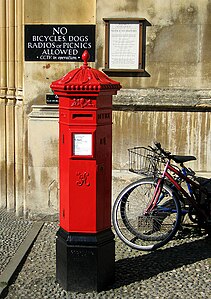

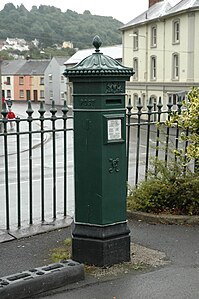








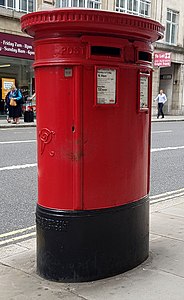



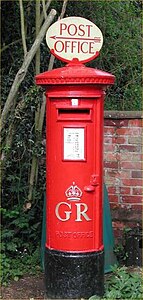




![Elizabeth II Type B pillar box (Nigerian pattern[clarification needed]) in Uttoxeter, Staffordshire, England.](http://upload.wikimedia.org/wikipedia/commons/thumb/f/ff/EIIR_Type_B_%28Nigerian_pattern%29%2C_Uttoxeter.JPG/225px-EIIR_Type_B_%28Nigerian_pattern%29%2C_Uttoxeter.JPG)


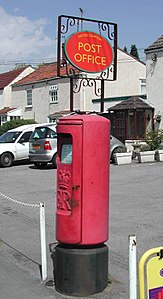
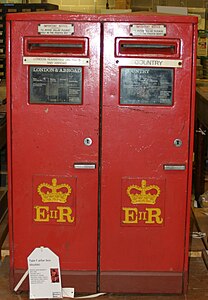

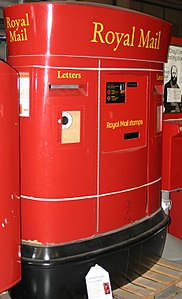







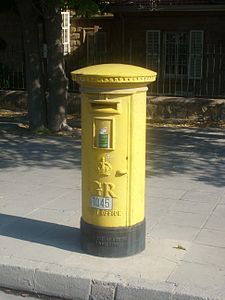


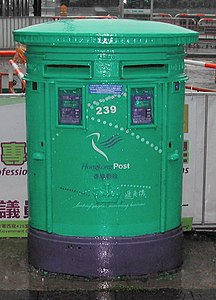

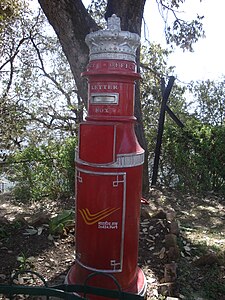
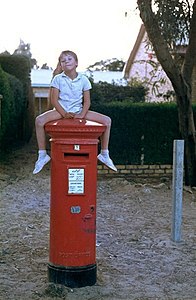

![A red pillar box in Vittoriosa, Malta. In the 1980s, royal cyphers were ground off the pillar boxes in Valletta and Floriana, but most others remained intact.[21]](http://upload.wikimedia.org/wikipedia/commons/thumb/3/3d/Vittorioso._EVIIR_Edwardian_Post_Box.%2CMalta_-_Flickr_-_sludgegulper.jpg/225px-Vittorioso._EVIIR_Edwardian_Post_Box.%2CMalta_-_Flickr_-_sludgegulper.jpg)

